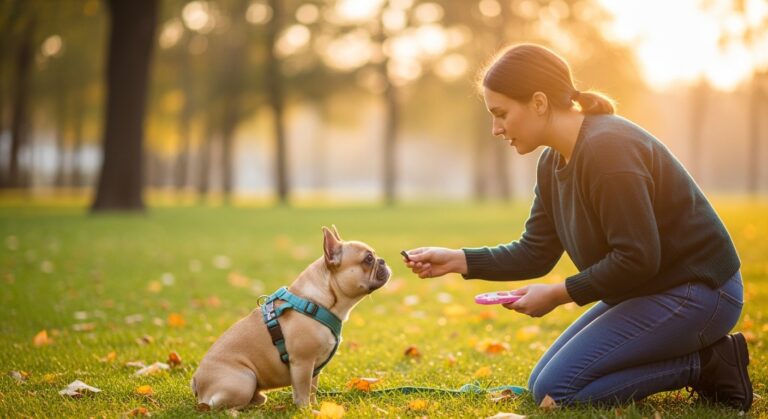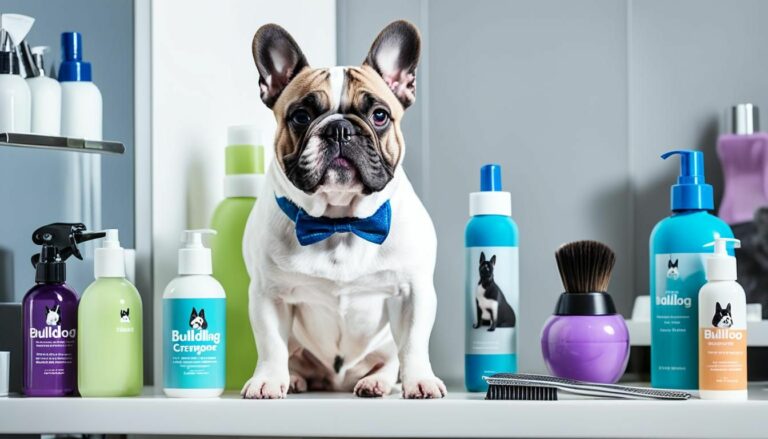Welcome to the ultimate resource for transforming your spirited French Bulldog into a calm, confident, and well-behaved companion. As seasoned Frenchie owners and trainers, we understand the unique charm and challenges these delightful dogs present. Their endearing personalities, coupled with a notorious streak of independence, mean that effective training requires a specific blend of patience, consistency, and above all, positive reinforcement. This comprehensive guide, meticulously crafted for 2025, deconstructs the art and science of French Bulldog training—from French Bulldog leash training to advanced techniques—providing you with battle-tested strategies to build an unbreakable bond and cultivate excellent behavior from puppyhood through adulthood. Let’s embark on this rewarding journey together!
Key Takeaways
- Start French Bulldog training early and consistently, focusing on positive reinforcement and reward-based methods.
- Address perceived ‘stubbornness’ by understanding their independent nature and using motivational techniques to encourage desired behaviors.
- Prioritize essential areas like house training, leash manners, socialization, and basic obedience commands for a well-adjusted Frenchie.
- Utilize appropriate training tools, such as a comfortable harness and high-value treats, to ensure safety and enhance the learning experience.
- Be patient, adaptable, and celebrate every small victory to foster a strong, trusting relationship with your French Bulldog.
Table of Contents
- Getting Started: French Bulldog Puppy Training Foundations
- The Power of Positive Reinforcement: Why It Works for Frenchies
- Overcoming the ‘Stubborn’ French Bulldog Stereotype
- Beyond Basics: Essential Training Pillars for Your Frenchie
- Choosing the Right Tools for Success
- Common Training Challenges & Solutions
- Conclusion: A Well-Trained Frenchie, A Happy Home
Getting Started: French Bulldog Puppy Training Foundations

Bringing home a French Bulldog puppy in 2025 is an exciting time, and the sooner you begin training, the better. These intelligent pups are incredibly receptive to learning during their early weeks and months. We’ve seen firsthand that a solid foundation laid in puppyhood makes all the difference in shaping a well-mannered adult dog. It’s not about imposing strict rules, but rather about guiding them gently and consistently towards understanding the world and their place within your family.
The Importance of an Early Start
French Bulldogs, while eager to please when properly motivated, can develop independent streaks. Starting training at 8-10 weeks of age allows you to capitalize on their natural curiosity and sponge-like ability to absorb new information. In our experience, puppies who begin training early are more confident, less prone to behavioral issues, and form stronger bonds with their owners. Consistency is your most powerful tool in these early stages, setting clear expectations from day one.
Core Training Techniques for Puppies
Leash Training
Introducing your Frenchie to a leash and harness early is crucial. Due to their unique brachycephalic (flat-faced) structure, a harness is always preferred over a collar to prevent pressure on their delicate airways. Start with short, positive sessions in a controlled environment, rewarding them generously for walking calmly beside you. Gradually increase the duration and expose them to different sights and sounds, always making it a positive experience.
House Training
Effective house training a French Bulldog puppy requires a consistent routine, patience, and vigilance. Establish a regular schedule for potty breaks – every 2-4 hours for young puppies, immediately after waking up, playing, and eating. Always take them to the designated potty spot, and as soon as they eliminate, offer immediate verbal praise and a high-value treat. Accidents will happen, but never scold; simply clean it thoroughly and recommit to your routine. For more detailed guidance, explore our complete guide to house training.
Basic Obedience Commands
Teaching commands like ‘Sit,’ ‘Stay,’ ‘Come,’ and ‘Down’ forms the bedrock of good behavior and safety. Use clear, concise verbal cues paired with hand signals. Reward instantly and enthusiastically when your Frenchie performs correctly. Remember that French Bulldogs can have relatively short attention spans, so keep training sessions brief (5-10 minutes), frequent, and fun. Consistent practice, even for a few minutes daily, will yield remarkable results. For safety and peace of mind, recall training is paramount – learning how to teach your French Bulldog to come when called can be a lifesaver. Mastering recall strengthens your bond and ensures their safety.
The Power of Positive Reinforcement: Why It Works for Frenchies
At the heart of successful French Bulldog training lies positive reinforcement. These sensitive dogs thrive on praise, affection, and tasty rewards. Unlike punishment-based methods, which can cause fear and distrust, positive reinforcement builds confidence and makes learning an enjoyable game for your Frenchie. It teaches them what you *want* them to do, rather than simply punishing what you don’t.
Rewards, Praise, and Motivation
Every time your Frenchie exhibits a desired behavior, acknowledge it immediately. This could be a click followed by a treat (if using clicker training), enthusiastic verbal praise (‘Good job!’), or a favorite toy. The key is to make the reward meaningful to your dog. Experiment with different treats and toys to discover what motivates your Frenchie most. In our experience, Frenchies respond incredibly well to this positive feedback loop, becoming eager participants in their own learning.
Patience and Understanding the Frenchie Psyche
French Bulldogs are known for their strong personalities. They aren’t inherently stubborn; rather, they’re intelligent and selective. If they don’t see the value in performing a command, they might just stare at you with those big, soulful eyes. This is where your patience and understanding come in. Instead of getting frustrated, try to make the task more appealing. Break it down into smaller steps, use higher-value rewards, or change your approach. Remember, training is a conversation, not a monologue. Understanding French Bulldog stress signs can also help you tailor your approach during training.
Overcoming the ‘Stubborn’ French Bulldog Stereotype

Many French Bulldog owners, ourselves included, have encountered moments where our beloved Frenchies seem to possess an iron will. This isn’t true stubbornness in a defiant sense; it’s often a combination of an independent nature and a strong desire to please *on their own terms*. Approaching this with the right mindset is crucial for effective French Bulldog training challenges.
Decoding Their Independence
Rather than viewing it as a flaw, consider their independence as a trait that requires a more engaging and persuasive training style. French Bulldogs thrive on novelty and positive reinforcement. If a task isn’t rewarding or clear, they’ll often disengage. We’ve found that short, upbeat training sessions with plenty of praise keep them motivated. Don’t be afraid to experiment with different types of treats or even a quick game with a favorite toy to rekindle their interest.
Building Motivation, Not Coercion
To bypass what seems like stubbornness, focus on making training irresistible. Use the highest value treats you can find (e.g., small pieces of cooked chicken or cheese) for new or difficult commands. Gradually fade these high-value rewards to less exciting ones as they become more proficient. Also, ensure you are creating a stimulating environment for your Frenchie, as promoting mental stimulation can significantly impact their willingness to engage in training.
Consistency is King
This cannot be stressed enough: consistency overcomes almost all perceived stubbornness. If your Frenchie knows that a command, like ‘Sit’, always results in a reward when performed correctly, they will eventually comply. Inconsistent application of rules or rewards will only confuse them and reinforce their independent decision-making. Set clear boundaries and stick to them, every single time.
Beyond Basics: Essential Training Pillars for Your Frenchie
While basic obedience forms the foundation, a truly well-adjusted French Bulldog needs more. Integrating these additional pillars into your focus training for French Bulldogs will ensure a happy, confident, and well-integrated family member.
Socialization: The Gateway to a Confident Dog
Early and ongoing socialization is paramount for French Bulldogs. Expose your puppy to a wide variety of sights, sounds, people, and other friendly, vaccinated dogs in a controlled, positive manner. Puppy classes are excellent for this. Proper socialization helps prevent fear-based aggression, anxiety, and reactivity later in life. A well-socialized Frenchie is a joy to take anywhere.
Crate Training: A Safe Haven
Crate training, when done correctly, provides your Frenchie with a secure den they can call their own. It’s an invaluable tool for house training, managing separation anxiety, and ensuring their safety when you can’t directly supervise them. Introduce the crate positively with treats and toys, never as punishment. It should be a comfortable, inviting space.
Impulse Control: Self-Regulation Skills
Teaching impulse control is about helping your Frenchie learn to manage their excitement and make good choices. This includes ‘leave it’ (ignoring enticing objects), ‘wait’ (pausing before going through a door or eating food), and polite greetings (not jumping on guests). These skills are essential for a harmonious household and safe public outings.
Choosing the Right Tools for Success

The right equipment can significantly enhance your French Bulldog training journey, making it more comfortable for your dog and more effective for you. Just as a craftsman needs the right tools, a dog owner needs the appropriate gear.
Harness vs. Collar: Prioritizing Comfort and Safety
As mentioned, a well-fitting harness is non-negotiable for French Bulldogs. Their brachycephalic structure makes them prone to respiratory issues, and a collar can put dangerous pressure on their trachea. A front-clip harness can also be particularly effective for teaching polite leash manners by gently redirecting their pull. Always ensure the harness fits snugly but allows full range of motion and doesn’t chafe.
High-Value Treats and Rewards
Motivation is key, and for many Frenchies, food is a powerful motivator. Keep a variety of low-calorie treats for French Bulldogs on hand, ranging from everyday kibble to high-value options like boiled chicken or cheese. Reserve the highest value treats for challenging new behaviors. Verbal praise and enthusiastic affection are also potent rewards, especially once your Frenchie understands the connection to their good behavior. Consider puzzle toys that dispense treats as another excellent way to promote mental stimulation and reward good behavior.
Training Aids: Clickers and Long Lines
A clicker is a precise communication tool that marks the exact moment your dog performs the desired behavior, followed immediately by a reward. This clarity significantly speeds up learning. For recall training and safe exploration in open spaces, a long line (15-30 feet) allows your Frenchie more freedom while still maintaining control and teaching them to stay within a reasonable distance.
Common Training Challenges & Solutions
Even with the best intentions, French Bulldog training can present hurdles. Recognizing and addressing these common challenges effectively is part of being a responsible and patient owner.
Nipping and Mouthing
Puppies naturally explore with their mouths. For Frenchie puppies, this mouthing can sometimes be persistent. Redirect inappropriate nipping onto appropriate chew toys. If they mouth your hands, let out a high-pitched ‘ouch!’ and immediately withdraw your attention for 10-15 seconds. This teaches them that mouthing stops the fun. Consistency is key to reducing mouthing in Frenchies.
Separation Anxiety
French Bulldogs are known for forming strong attachments to their humans, which can sometimes manifest as separation anxiety. Desensitize them to your departures by starting with very short absences and gradually increasing the duration. Provide stimulating toys or a food-stuffed Kong before you leave. Never make a big fuss when leaving or returning. If severe, consult with a professional positive reinforcement trainer or veterinary behaviorist.
Excessive Barking
While not typically excessive barkers, Frenchies can develop barking habits out of boredom, attention-seeking, or alert barking. Identify the trigger: are they bored? Provide more mental and physical exercise. Are they seeking attention? Ignore the barking and reward silence. Are they alert barking at sounds? Teach a ‘quiet’ command by rewarding them for stopping their bark when cued.
Conclusion: A Well-Trained Frenchie, A Happy Home

Training your French Bulldog is an ongoing journey filled with learning, laughter, and an ever-deepening bond. By committing to positive reinforcement, understanding their unique personality, and tackling challenges with patience and consistency, you’re not just teaching commands; you’re building a confident, well-adjusted companion for life. Remember, every Frenchie is an individual, so celebrate their quirks and tailor your approach to their specific needs. In 2025 and beyond, a well-trained French Bulldog isn’t just a dream – it’s an achievable reality that enriches both your lives. Embrace the process, cherish the moments, and enjoy the incredible companionship your Frenchie brings.
Helpful Resources & References
- How to Train a French Bulldog Puppy: Frenchie Growth …
- A Guide to Puppy Breeds: French Bulldog!
- Are Frenchies difficult to train in your experience
- Training your French Bulldog
- How to House Train a French Bulldog – Vince Cincy
Hi, I’m Alex! At FrenchyFab.com, I share my expertise and love for French Bulldogs. Dive in for top-notch grooming, nutrition, and health care tips to keep your Frenchie thriving.


